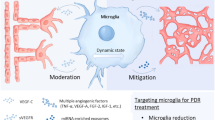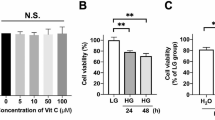Abstract
Understanding how energy metabolism and related proteins influence neural progenitor cells in adult tissues is critical for developing new strategies in clinical tissue regeneration therapy. We have recently reported that a subtoxic concentration of glutamate-induced neural progenitor cells in the mature ex vivo rat retina. We herein explore changes in the metabolic pathways during the process. We firstly observed an increase in lactate and lactate dehydrogenase concentration in the glutamate-treated retina. We then investigated the levels of glycolytic enzymes and confirmed significant upregulation of pyruvate kinase M type (PKM), especially PKM2, enolase, phosphoglycerate mutase 1 (PGAM1), and inosine-5′-monophosphate dehydrogenase (IMPDH1) in the glutamate-treated retina compared to the untreated retina. An analysis of the subcellular localization of PKM2 revealed nuclear translocation in the treated retina, which has been reported to regulate cell cycle proliferation and glycolytic enzymes. Our findings indicate that the mature rat retina undergoes an increase in aerobic glycolysis. PKM2, both in the cytoplasm and in the nucleus, may thus play an important role during neural progenitor cell induction, as it does in other proliferating cells.





Similar content being viewed by others
References
Geschwind DH, Ou J, Easterday MC, Dougherty JD, Jackson RL, Chen Z, Antoine H, Terskikh A, Weissman IL, Nelson SF, Kornblum HI (2001) A genetic analysis of neural progenitor differentiation. Neuron 29:325–339
Karsten SL, Kudo LC, Jackson R, Sabatti C, Kornblum HI, Geschwind DH (2003) Global analysis of gene expression in neural progenitors reveals specific cell-cycle, signaling, and metabolic networks. Dev Biol 261:165–182
Ivanova NB, Dimos JT, Schaniel C, Hackney JA, Moore KA, Lemischka IR (2002) A stem cell molecular signature. Science 298:601–604
Agathocleous M, Love NK, Randlett O, Harris JJ, Liu J, Murray AJ, Harris WA (2012) Metabolic differentiation in the embryonic retina. Nat Cell Biol 14:859–864
Fischer AJ, Reh TA (2001) Müller glia are a potential source of neural regeneration in the postnatal chicken retina. Nat Neurosci 4:247–252
Takeda M, Takamiya A, Jiao JW, Cho KS, Trevino SG, Matsuda T, Chen DF (2008) Alpha-aminoadipate induces progenitor cell properties of Müller glia in adult mice. Invest Ophthalmol Vis Sci 49:1142–1150
Tokuda K, Kuramitsu Y, Byron B, Kitagawa T, Tokuda N, Kobayashi D, Nagayama M, Araki N, Sonoda KH, Nakamura K (2015) Up-regulation of DRP-3 long isoform during the induction of neural progenitor cells by glutamate treatment in the ex vivo rat retina. Biochem Biophys Res Commun 463:593–599
Tokuda K, Zorumski CF, Izumi Y (2009) Involvement of illumination in indocyanine green toxicity after its washout in the ex vivo rat retina. Retina 29:371–379
Lowry OH, Rosebrough NJ, Farr AL, Randall RJ (1951) Protein measurement with the Folin phenol reagent. J Biol Chem 193:265–275
Kuramitsu Y, Harada T, Takashima M, Yokoyama Y, Hidaka I, Iizuka N, Toda T, Fujimoto M, Zhang X, Sakaida I, Okita K, Oka M, Nakamura K (2006) Increased expression and phosphorylation of liver glutamine synthetase in well-differentiated hepatocellular carcinoma tissues from patients infected with hepatitis C virus. Electrophoresis 27:1651–1658
Prigione A, Fauler B, Lurz R, Lehrach H, Adjaye J (2010) The senescence-related mitochondrial/oxidative stress pathway is repressed in human induced pluripotent stem cells. Stem Cells 28:721–733
Candelario KM, Shuttleworth CW, Cunningham LA (2013) Neural stem/progenitor cells display a low requirement for oxidative metabolism independent of hypoxia inducible factor-1alpha expression. J Neurochem 125:420–429
Wang HJ, Hsieh YJ, Cheng WC, Lin CP, Lin YS, Yang SF, Chen CC, Izumiya Y, Yu JS, Kung HJ, Wang WC (2014) JMJD5 regulates PKM2 nuclear translocation and reprograms HIF-1α-mediated glucose metabolism. Proc Natl Acad Sci USA 111:279–284
Bani-Yaghoub M, Felker JM, Ozog MA, Bechberger JF, Naus CC (2001) Array analysis of the genes regulated during neuronal differentiation of human embryonal cells. Biochem Cell Biol 79:387–398
Venkatesan A, Uzasci L, Chen Z, Rajbhandari L, Anderson C, Lee MH, Bianchet MA, Cotter R, Song H, Nath A (2011) Impairment of adult hippocampal neural progenitor proliferation by methamphetamine: role for nitrotyrosination. Mol Brain 4:28. doi:10.1186/1756-6606-4-28
Durany N, Joseph J, Campo E, Molina R, Carreras J (1997) Phosphoglycerate mutase, 2,3-bisphosphoglycerate phosphatase and enolase activity and isoenzymes in lung, colon and liver carcinomas. Br J Cancer 75:969–977
Yang W, Xia Y, Ji H, Zheng Y, Liang J, Huang W, Gao X, Aldape K, Lu Z (2011) Nuclear PKM2 regulates β-catenin transactivation upon EGFR activation. Nature 480:118–122
McLean JE, Hamaguchi N, Belenky P, Mortimer SE, Stanton M, Hedstrom L (2004) Inosine 5′-monophosphate dehydrogenase binds nucleic acids in vitro and in vivo. Biochem J 379:243–251
Taniguchi K, Ito Y, Sugito N, Kumazaki M, Shinohara H, Yamada N, Nakagawa Y, Sugiyama T, Futamura M, Otsuki Y, Yoshida K, Uchiyama K, Akao Y (2015) Organ-specific PTB1-associated microRNAs determine expression of pyruvate kinase isoforms. Sci Rep 5:8647. doi:10.1038/srep08647
Noguchi T, Yamada K, Inoue H, Matsuda T, Tanaka T (1987) The L- and R-type isozymes of rat pyruvate kinase are produced from a single gene by use of different promoters. J Biol Chem 262:14366–14371
Noguchi T, Inoue H, Tanaka T (1986) The M1- and M2-type isozymes of rat pyruvate kinase are produced from the same gene by alternative RNA splicing. J Biol Chem 261:13807–13812
Jurica MS, Mesecar A, Heath PJ, Shi W, Nowak T, Stoddard BL (1998) The allosteric regulation of pyruvate kinase by fructose-1,6-bisphosphate. Structure 6:195–210
Vander Heiden MG, Locasale JW, Swanson KD, Sharfi H, Heffron GJ, Amador-Noguez D, Christofk HR, Wagner G, Rabinowitz JD, Asara JM, Cantley LC (2010) Evidence for an alternative glycolytic pathway in rapidly proliferating cells. Science 329:1492–1499
Wisniewska MB (2013) Physiological role of β-catenin/TCF signaling in neurons of the adult brain. Neurochem Res 38:1144–1155
Gao X, Wang H, Yang JJ, Liu X, Liu ZR (2012) Pyruvate kinase M2 regulates gene transcription by acting as a protein kinase. Mol Cell 45:598–609
Yang W, Zheng Y, Xia Y, Ji H, Chen X, Guo F, Lyssiotis CA, Aldape K, Cantley LC, Lu Z (2012) ERK1/2-dependent phosphorylation and nuclear translocation of PKM2 promotes the Warburg effect. Nat Cell Biol 14:1295–1304
Fothergill-Gilmore LA, Watson HC (1990) Phosphoglycerate mutases. Biochem Soc Trans 18:190–193
Yalowitz JA, Jayaram HN (2000) Molecular targets of guanine nucleotides in differentiation, proliferation and apoptosis. Anticancer Res 20:2329–2338
Natsumeda Y, Ohno S, Kawasaki H, Konno Y, Weber G, Suzuki K (1990) Two distinct cDNAs for human IMP dehydrogenase. J Biol Chem 265:5292–5295
Bowne SJ, Sullivan LS, Mortimer SE, Hedstrom L, Zhu J, Spellicy CJ, Gire AI, Hughbanks-Wheaton D, Birch DG, Lewis RA, Heckenlively JR, Daiger SP (2006) Spectrum and frequency of mutations in IMPDH1 associated with autosomal dominant retinitis pigmentosa and Leber congenital amaurosis. Invest Ophthalmol Vis Sci 47:34–42
Mortimer SE, Xu D, McGrew D, Hamaguchi N, Lim HC, Bowne SJ, Daiger SP, Hedstrom L (2008) IMP dehydrogenase type 1 associates with polyribosomes translating rhodopsin mRNA. J Biol Chem 283:36354–36360
Bowne SJ, Sullivan LS, Blanton SH, Cepko CL, Blackshaw S, Birch DG, Hughbanks-Wheaton D, Heckenlively JR, Daiger SP (2002) Mutations in the inosine monophosphate dehydrogenase 1 gene (IMPDH1) cause the RP10 form of autosomal dominant retinitis pigmentosa. Hum Mol Genet 11:559–568
Kennan A, Aherne A, Palfi A, Humphries M, McKee A, Stitt A, Simpson DA, Demtroder K, Orntoft T, Ayuso C, Kenna PF, Farrar GJ, Humphries P (2002) Identification of an IMPDH1 mutation in autosomal dominant retinitis pigmentosa (RP10) revealed following comparative microarray analysis of transcripts derived from retinas of wild-type and Rho(-/-) mice. Hum Mol Genet 11:547–557
Acknowledgments
The authors thank Yukari Mizuno and Shizuka Murata for technical assistance and support. Immunoblot detection by LAS-1000 and colorimetric measurement by iMark were carried out at the Gene Research Centre of Yamaguchi University. This work was supported by Grants-in-Aid from the Ministry of Education, Science, Sports, and Culture of Japan (No. 26293373 to Koh-Hei Sonoda).
Author information
Authors and Affiliations
Corresponding author
Ethics declarations
Conflict of interest
The authors declare that they have no conflict of interest.
Rights and permissions
About this article
Cite this article
Tokuda, K., Kuramitsu, Y., Baron, B. et al. Changes in metabolic proteins in ex vivo rat retina during glutamate-induced neural progenitor cell induction. Mol Cell Biochem 419, 177–184 (2016). https://doi.org/10.1007/s11010-016-2769-z
Received:
Accepted:
Published:
Issue Date:
DOI: https://doi.org/10.1007/s11010-016-2769-z




